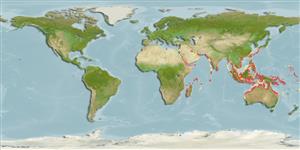Common names from other countries
Environment: milieu / climate zone / depth range / distribution range
Ökologie
seewasser; süßwasser; brackwasser benthopelagisch; amphidrom (Ref. 51243); tiefenbereich 0 - 30 m (Ref. 43448). Tropical; 30°N - 26°S
Indo-West Pacific: northern Indian Ocean and the Indo-Australian Archipelago. A lessepsian migrant, now prevalent in the Mediterranean (Ref. 43448).
Size / Gewicht / Alter
Maturity: Lm ? range ? - ? cm
Max length : 30.0 cm TL Männchen/unbestimmt; (Ref. 58652)
Rückenflossenstacheln (insgesamt): 11 - 12; Rückenflossenweichstrahlen (insgesamt): 9-11; Afterflossenstacheln 3; Afterflossenweichstrahlen: 8 - 9
Adults inhabit coastal waters, entering brackish estuaries (Ref. 3132) and mangrove areas (Ref. 7300). Also in fresh waters (Ref. 30573). Feed on fishes and invertebrates. Eggs are guarded and fanned by the male parent (Ref. 205).
Life cycle and mating behavior
Geschlechtsreife | Fortpflanzung | Ablaichen | Eier | Fecundity | Larven
Eggs are guarded and fanned by the male parent (Ref. 205).
Paxton, J.R., D.F. Hoese, G.R. Allen and J.E. Hanley, 1989. Pisces. Petromyzontidae to Carangidae. Zoological Catalogue of Australia, Vol. 7. Australian Government Publishing Service, Canberra, 665 p. (Ref. 7300)
IUCN Rote Liste Status (Ref. 130435)
CITES (Ref. 128078)
Not Evaluated
Bedrohung für Menschen
Harmless
Nutzung durch Menschen
Fischereien: weniger kommerziell
Tools
Zusatzinformationen
Download XML
Internet Quellen
Estimates based on models
Preferred temperature (Ref.
115969): 24.8 - 29.3, mean 28.5 (based on 3744 cells).
Phylogenetic diversity index (Ref.
82804): PD
50 = 0.6250 [Uniqueness, from 0.5 = low to 2.0 = high].
Bayesian length-weight: a=0.00479 (0.00188 - 0.01218), b=3.09 (2.87 - 3.31), in cm Total Length, based on LWR estimates for this (Sub)family-body shape (Ref.
93245).
Trophic level (Ref.
69278): 3.4 ±0.47 se; based on food items.
Widerstandsfähigkeit (Ref.
120179): mittel, Verdopplung der Population dauert 1,4 - 4,4 Jahre. (Preliminary K or Fecundity.).
Fishing Vulnerability (Ref.
59153): Low vulnerability (20 of 100).
